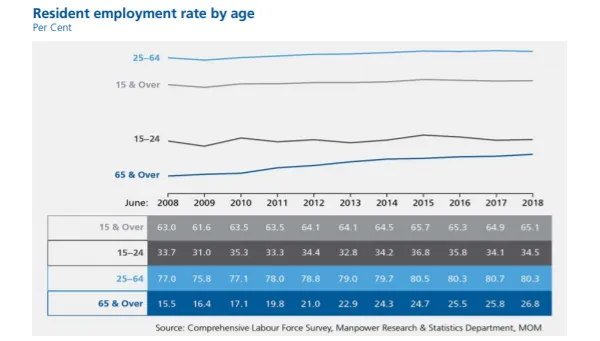
Employment rates and average incomes rise in 2018
Employment rates for residents 15 & over rose from 64.9% in 2017 to 65.1%.
Employment rates and average incomes for Singapore residents mostly grew in 2018, the Ministry of Manpower (MOM) revealed.
According to an advanced release, employment rates for residents aged 15 & over inched up from 64.9% in 2017 and 65.1% in 2018. The employment rate for older residents aged 65 & over from 25.8% to 26.8%, with MoM citing "efforts to improve the employability of older workers."
The employment rate for youths aged 15 to 24 also increased from 34.1% to 34.5%, due to more taking on internships or vacation jobs.
Meanwhile, the employment rate for residents aged 25 to 64 fell slightly from 80.7% in 2017 to 80.3% in 2018. "This mainly reflected a decline in employment rate among women in their 30s, from 82.1% to 80.7%, as more stayed outside the labour force during the year to care for their families," MoM said.
The employment rate stayed high at around 80% for residents aged 25-64. According to MoM, Singapore ranks favourably compared with OECD economies (eighth), especially in terms of full-time employment rate (fourth).
The real median income of full-time employed residents grew by 3.5% per annum from June 2013 to June 2018. This is higher than the 1.9% rate in the previous five years.
According to MoM, sustained efforts to raise the incomes of low-wage workers helped real income growth at the 20th percentile (4.2% p.a.P) grow faster than at the median (3.5% p.a.P) in the recent five years (June 2013 to June 2018), narrowing their gap with the median worker.
"As more job seekers found work, we saw a broad-based moderation in unemployment rate for Professionals, Managers, Executives and Technicians (PMETs) and non-PMETs," the report noted.
The unemployment rate for PMETs aged 50 & over softened even as their long-term unemployment rate rose. "This suggests that whilst such PMETs benefitted from improved labour market conditions, there remains a group who face greater difficulty returning to the workforce," MoM said.
Although the time-related under-employment rate rose from 3% in 2017 to 3.3% in June 2018, there was no evidence of an increase in involuntary time-related under-employment as the proportion of part-timers who wanted to work additional hours but could not find a full-time job was largely the same.
The proportion of resident employees on fixed-term contracts rose from 6.4% to 7.2% even as the share of those in casual or on-call employment held steady. "This suggests greater caution among employers about hiring as the economy continues to restructure, even as the labour market has tightened," MoM said.


![SBR 5 Lorem Ipsum News 2 [8 May]](https://cmg-qa.s3.ap-southeast-1.amazonaws.com/s3fs-public/styles/exclusive_featured_article/public/2025-05/a_hand_pointing_to_a_futuristic_technology_5b87c9d0e3_3.png.webp?itok=M3Hf-9XR)
![SBR 4 Lorem Ipsum [8 May Top Stories]](https://cmg-qa.s3.ap-southeast-1.amazonaws.com/s3fs-public/styles/exclusive_featured_article/public/2025-05/a_hand_pointing_to_a_futuristic_technology_5b87c9d0e3_2.png.webp?itok=2m5Wl0MX)


![Exclusive three SBR 12 Lorem Ipsum [8 May]](https://cmg-qa.s3.ap-southeast-1.amazonaws.com/s3fs-public/styles/exclusive_featured_article/public/2025-05/a_hand_pointing_to_a_futuristic_technology_5b87c9d0e3_11.png.webp?itok=8kn_UIfA)
![SBR 3 Lorem Ipsum [ Exclusive 2]](https://cmg-qa.s3.ap-southeast-1.amazonaws.com/s3fs-public/styles/exclusive_featured_article/public/2025-05/a_hand_pointing_to_a_futuristic_technology_5b87c9d0e3_1.png.webp?itok=YCyjLegJ)
![SBR 2 Lorem Ipsum [8 May]](https://cmg-qa.s3.ap-southeast-1.amazonaws.com/s3fs-public/styles/exclusive_featured_article/public/2025-05/a_hand_pointing_to_a_futuristic_technology_5b87c9d0e3_0.png.webp?itok=_cKD-29o)

![Video [Event News]](https://cmg-qa.s3.ap-southeast-1.amazonaws.com/s3fs-public/styles/event_news_featured_article/public/2025-05/screenshot-2025-05-08-at-4.58.53-pm_0.png.webp?itok=Kud35sMs)
![Event News SBR 9 Lorem Ipsum [8 may]](https://cmg-qa.s3.ap-southeast-1.amazonaws.com/s3fs-public/styles/event_news_thumbnail/public/2025-05/a_hand_pointing_to_a_futuristic_technology_5b87c9d0e3_8.png.webp?itok=DTh_dbYp)
![Event News SBR 9 Lorem Ipsum [8 May]](https://cmg-qa.s3.ap-southeast-1.amazonaws.com/s3fs-public/styles/event_news_thumbnail/public/2025-05/a_hand_pointing_to_a_futuristic_technology_5b87c9d0e3_7.png.webp?itok=vzDAzb6V)
![Event News SBR 8 Lorem Ipsum [8 May]](https://cmg-qa.s3.ap-southeast-1.amazonaws.com/s3fs-public/styles/event_news_thumbnail/public/2025-05/a_hand_pointing_to_a_futuristic_technology_5b87c9d0e3_6.png.webp?itok=jvHFc4P6)
![Video [Event News]](https://cmg-qa.s3.ap-southeast-1.amazonaws.com/s3fs-public/styles/video_thumbnail/public/2025-05/screenshot-2025-05-08-at-4.58.53-pm_0.png.webp?itok=yZnI0YBb)
![Video 1 SBR [8 May]](https://cmg-qa.s3.ap-southeast-1.amazonaws.com/s3fs-public/styles/video_thumbnail/public/2025-05/screenshot-2025-05-08-at-4.58.53-pm.png.webp?itok=9AAeRz_k)

 Advertise
Advertise

